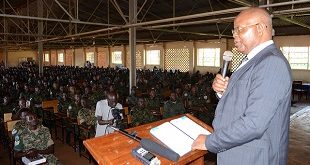
Kampala, Uganda | THE INDEPENDENT | Bicycles became the thing when president Yoweri Museveni announced a countrywide lockdown a fortnight ago as part of the Covid-19 prevention measures. Many people are now seen riding to the market, their work place or run several other errands.
In his directive, the president urged people to use bicycles or walk fronting this as way of physical distancing which could further halt transmission of the disease. However, Dr. Paul Stephen Ayella Ataro, the Physician Uganda Netball Federation and Vice President Uganda Medical Association says the risk for Covid-19 infection is higher for people in motion.
He explains that biking as encouraged by the president for instance increases the breathing rate, stimulates cough and tendency to sneeze just like any other form of exertion. Ayella, who was reacting to a Dutch Belgian study whose results were released on Friday last week said the recommendation of keeping a meter or two apart as many countries have put it for physical distancing doesn’t work for people in motion.
According to the study, Sports scientists found that running, walking or cycling in each other’s slipstream even if two meters apart cannot spare one from the virus that is ravaging the whole world. Giving an update via his twitter handle, Bert Blocken, an aerodynamicist and Professor of Civil Engineering at Eindhoven University of Technology Netherlands and KU Leuven Belgium who coordinated the study said that people can actually run close to each other but be a bit safer than 1.5 meters when behind each other.
The researchers who displayed their results in a series of animations and figures recommend that the distance of people moving in the same direction should be 4 to 5 meters whereas for those running or slow biking should be at least 10 meters.
For those that are doing hard biking it should be at least 20 meters. Blocken explains that if someone sneezes or coughs while walking or cycling, the micro droplets are entrained in the wake or slipstream behind them and that the other person who runs just behind this leading person in the slip stream then moves through that cloud of droplets.
He describes the slipstream as something similar to a vacuum or drag effect which occurs when the regular airflow is disturbed by someone who was in motion. According to a paper published on the Eindhoven University website, to reach to these conclusions, the researchers stimulated the release of saliva particles from people in motion and in different configurations.
This is the kind of modeling used to improve performance levels of athletes as staying in each other’s slipstream is very effective in helping them go at a higher speed. Ayella, who is also an expert in sports medicine, agrees with the findings of the study.
To him government needs to put such science into consideration when coming up with such directives. “People biking ought to be far apart from each other otherwise risk of infection is high with spitting, sneezing and coughing as common mannerisms they are bound to be at risk when distance is not kept. We need to do all context research to understand more on transmission,” he said.
******
URN
 The Independent Uganda: You get the Truth we Pay the Price
The Independent Uganda: You get the Truth we Pay the Price


